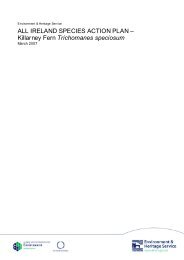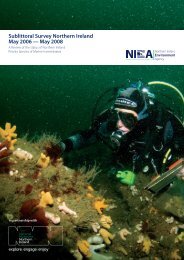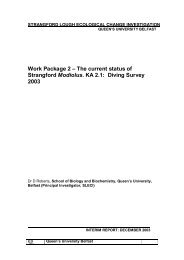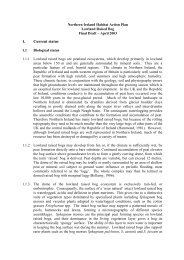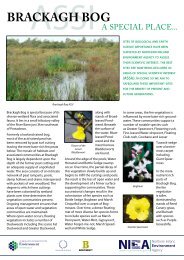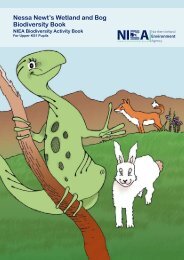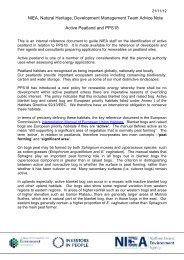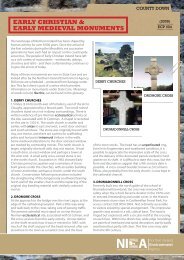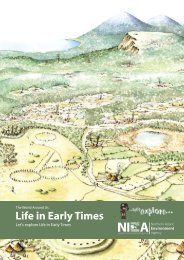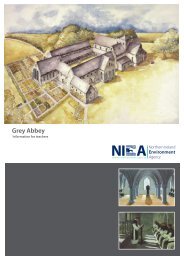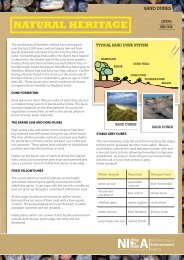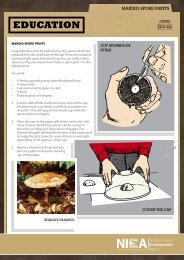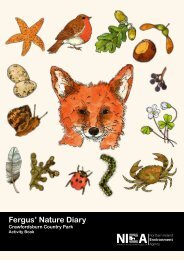Binevenagh Nature Reserve Information for Teachers (.PDF 0.97
Binevenagh Nature Reserve Information for Teachers (.PDF 0.97
Binevenagh Nature Reserve Information for Teachers (.PDF 0.97
Create successful ePaper yourself
Turn your PDF publications into a flip-book with our unique Google optimized e-Paper software.
<strong>Binevenagh</strong> <strong>Nature</strong> <strong>Reserve</strong><br />
<strong>Teachers</strong> Notes
<strong>Binevenagh</strong> <strong>Nature</strong> <strong>Reserve</strong> www.ni-environment.gov.uk<br />
Preliminary Remarks<br />
These notes have been compiled to be used principally<br />
by teachers of KS2 and above and their pupils.<br />
However, they will be of interest to other visitors as<br />
well. They cover many of the themes in the revised<br />
National Curriculum.<br />
Northern Ireland Environment Agency (NIEA) does not<br />
encourage independent visits to this reserve as<br />
cattle roam across it.<br />
Visits can be arranged and further in<strong>for</strong>mation<br />
obtained by contacting the following:<br />
Northern Ireland Environment Agency<br />
North West <strong>Nature</strong> <strong>Reserve</strong>s The Educator<br />
Old Roe Valley Hospital Roe Valley Country Park<br />
<strong>Binevenagh</strong> Drive 41 Dogleap Rd<br />
Limavady Limavady<br />
BT 49 0AQ BT49 9NN<br />
Tel: 028 7776 3982 Tel: 028 7776 7532<br />
1
www.ni-environment.gov.uk<br />
Introduction<br />
This National <strong>Nature</strong> <strong>Reserve</strong> (NNR), designated in<br />
1987, comprises 70 hectares lying to the north of<br />
<strong>Binevenagh</strong> Mountain. The reserve is one of 50 in<br />
Northern Ireland administered by the Northern Ireland<br />
Environment Agency (NIEA). For some time the site<br />
has been recognised as being of major environmental<br />
importance. It was designated as an Area of Special<br />
Scientific Interest (ASSI) in 2000. It is also a candidate<br />
Special Area of Conservation (SAC), which will bring the<br />
site into line with European Union directives. As well as<br />
the NNRs, NIEA looks after over 200 ASSI’s and a further<br />
60 SAC’s,<br />
(or sites expected to receive SAC status). In addition<br />
plans are in place to designate the surrounding area<br />
as an Area of Outstanding Natural Beauty (AONB).<br />
Each designated site is chosen because it has<br />
something special in terms of the landscape and<br />
ecology it contains.<br />
<br />
<br />
<br />
<br />
<br />
<br />
<br />
<br />
<br />
<strong>Binevenagh</strong> <strong>Nature</strong> <strong>Reserve</strong><br />
The reserve is a fascinating place with an atmosphere all<br />
of its own. On clear days there are magnificent views: to<br />
the west is Lough Foyle stretching down to Londonderry<br />
and beyond; to the north is the Inishowen peninsula<br />
and to the east one can often see as far as Scotland.<br />
Immediately below is the Magilligan area spread out<br />
like a map. The Magilligan area has only <strong>for</strong>med since<br />
the last ice age 12,000 years ago as the Foyle Estuary<br />
gradually filled with sand deposits. At other times<br />
there is an eerie feeling as the huge <strong>Binevenagh</strong> cliffs<br />
cast their shadows over the ground below. Standing<br />
below these cliffs, it is easy to imagine that a lost world<br />
can be found on the plateau above, reminding one of<br />
Arthur Conan Doyle’s ‘The Lost World’. In this novel the<br />
characters stumble into a lost world where dinosaurs<br />
still roam. There is no chance of this happening on your<br />
visit, but <strong>Binevenagh</strong> does have many links with the past<br />
going back to the time of the dinosaurs.<br />
<br />
<br />
<br />
<br />
<br />
<br />
<br />
<br />
2
<strong>Binevenagh</strong> <strong>Nature</strong> <strong>Reserve</strong><br />
The Walk<br />
Visits to the reserve can be arranged with NIEA staff at<br />
North West <strong>Nature</strong> <strong>Reserve</strong>s or Roe Valley Country Park.<br />
The best approach to the reserve is from the car park<br />
of St Aidan’s Church, grid reference: 673314. The walk<br />
is approximately 4 km. It begins with a steep ascent,<br />
starting at 50 m above sea level and climbing steeply to<br />
nearly 200 m above sea level in just 1 km. A narrow path<br />
leads up through the woods until you reach the reserve.<br />
Continue climbing until you come to the edge of the<br />
cliffs. Make your way eastwards across the reserve using<br />
the various stiles. You will eventually pass through a<br />
small steep valley. You leave the reserve and move on to<br />
a <strong>for</strong>estry road. From here you will be able to make your<br />
way back to the car park at St Aidan’s.<br />
3<br />
Geology and Geomorphology<br />
www.ni-environment.gov.uk<br />
Part of the reason why <strong>Binevenagh</strong> is designated as a<br />
reserve is because of its geology and geomorphology.<br />
Geology means the study of rocks. Geomorphology<br />
deals with the way our landscape has changed over<br />
time. <strong>Binevenagh</strong> contains many examples of the<br />
<strong>for</strong>ces that have shaped our landscape: volcanoes,<br />
glaciers, weather and the influence of man. The most<br />
obvious feature of the site is the basalt cliffs, which<br />
rise majestically above it. These were <strong>for</strong>med some<br />
55 million years ago, at the same time as the Giant’s<br />
Causeway. The basalt was <strong>for</strong>med as thick lava gradually<br />
cooled in a series of flows. These can clearly be seen as<br />
distinct bands in the rock.<br />
Another feature of the cliffs is the huge areas of slippage<br />
at the western end of the cliffs. These were <strong>for</strong>med as<br />
a result of the action of ice. During the last Ice Age a<br />
glacier moving from west to east undercut the softer<br />
clays and chalk, which are the more ancient rocks<br />
laying below the basalt. When the ice melted 12,000<br />
years ago there would have been nothing to support<br />
the rock and it slumped down to its present position.<br />
To understand the process it might be instructive to<br />
think of a river undercutting its banks leading to the<br />
collapse of the bank above. In between the sheer basalt<br />
cliffs and the grassy slope is an area of large boulders.<br />
These rocks have fallen from the cliff over time. This is a<br />
normal feature of steep cliffs and is known as the scree<br />
slope. It is caused by the action of ice expanding and<br />
contracting on the steep rock face, known as freezethaw<br />
weathering. It is the same process that cracks<br />
pipes in cold weather.
www.ni-environment.gov.uk<br />
Plants<br />
The crags of the cliffs are the habitat of rare sub-arctic and<br />
alpine plants such as the mountain avens and the purple<br />
saxifrage. These flowers grow in very few places in Ireland,<br />
but they have survived high on the cliffs <strong>for</strong> thousands of<br />
years since the last Ice Age where the soils and micro-climate<br />
suit them. The cliffs face north and are there<strong>for</strong>e colder than<br />
the surrounding area. The cliffs are also the habitat of rare<br />
mosses and clinging on to the cliffs are some of Ireland’s<br />
rarest tree, the juniper. On the scree slopes below the cliffs<br />
are rare ferns.<br />
An important aspect of the reserve is the grassland below the<br />
cliffs. In their natural state there would not be grasslands here<br />
at all. The natural vegetation of most of Ireland is woodland.<br />
Be<strong>for</strong>e the first farmers arrived here 6,000 years ago 80% of<br />
Ireland was covered in thick deciduous <strong>for</strong>est. These Neolithic<br />
farmers began to cut down these original woods to provide<br />
fuel and building material <strong>for</strong> their homes and farms and<br />
to make way <strong>for</strong> their fields. Over the next 6,000 years the<br />
<strong>for</strong>ests gradually disappeared to perhaps 1% of the total<br />
area of Ireland. The fields were largely used <strong>for</strong> animal<br />
grazing. It is the cattle and sheep that prevent the <strong>for</strong>est<br />
re-establishing itself because they eat the young shoots<br />
of any trees that might begin to grow.<br />
We often think of the countryside as completely natural and<br />
the town landscape as being man made. This is not really<br />
the case. All of our landscapes, whether they are in the<br />
countryside or in the middle of towns, have been to a greater<br />
or lesser extent affected by people. There is no completely<br />
natural landscape in Ireland. Since people arrived here 9,000<br />
years ago they have altered the landscape in many ways and<br />
the area of the reserve is just one example. Wild animals like<br />
bears and wolves, which lived in the <strong>for</strong>ests, have become<br />
extinct. Domestic animals have been allowed to graze and<br />
crops have been planted. A huge coniferous <strong>for</strong>est has been<br />
planted nearby. There are buildings, stone walls and fences.<br />
The landscape we see today is a combination of natural<br />
<strong>for</strong>ces and the work of people. <strong>Binevenagh</strong> reserve is a good<br />
example of this process.<br />
Although the grassland below the cliff is not strictly natural<br />
it is very important that it is kept in its present state. The<br />
grassland below the cliffs has never been treated with<br />
fertiliser or pesticides. This makes it fairly rare. As long as it is<br />
sensibly grazed it will remain the home of a wide variety<br />
of grasses and flowers. These may have been common at one<br />
time in many locations but modern farming practice has led<br />
to their becoming much rarer.<br />
Bracken Fern<br />
Purple Saxifrage<br />
Mountain Avens<br />
<strong>Binevenagh</strong> <strong>Nature</strong> <strong>Reserve</strong><br />
4
<strong>Binevenagh</strong> <strong>Nature</strong> <strong>Reserve</strong><br />
Fungi<br />
Mushrooms are examples of a group of living things<br />
called fungi. They are not plants because they do not<br />
photosynthesise. They are called decomposers because<br />
they live by breaking down dead material from plants<br />
and animals. This is a very important process as they help<br />
recycle the minerals back into the soil allowing plants<br />
to continue growing. The reserve is of international<br />
importance <strong>for</strong> wax cap mushrooms. They have this<br />
name because their surface has a waxy texture. Some<br />
of them are a bright pink colour. Nineteen species have<br />
been identified on the site, which makes it of huge<br />
importance in European terms. Only the Curragh in<br />
Kildare and one site in Fermanagh have a greater variety<br />
of these fungi. They normally appear in autumn.<br />
Vegetation transect<br />
Your walk from St Aidan’s church to the foot of the cliffs<br />
allows you to see the changes in plants that grow as<br />
you gradually gain height. Beginning at the church<br />
you are surrounded by fields given over to lowland<br />
grazing. There are small fields enclosed by hawthorn and<br />
blackthorn hedges. As you climb up, you pass through<br />
the woods. You will be able to see the differences<br />
between planted woodland and natural woodland<br />
very well. The planted woodland consists of mature<br />
coniferous trees, mostly Sitka Spruce. They are arranged<br />
in straight lines and are very close together. They are<br />
quite gloomy and very little grows below them because<br />
Diagram of <strong>Binevenagh</strong> <strong>Nature</strong> <strong>Reserve</strong> Transect<br />
<br />
5<br />
<br />
<br />
<br />
<br />
<br />
<br />
<br />
<br />
<br />
<br />
<br />
<br />
www.ni-environment.gov.uk<br />
the sunlight cannot reach the ground. You may be<br />
able to estimate the age of the <strong>for</strong>est by counting the<br />
rings on the tree trunks of trees that have been felled.<br />
In contrast the natural woodland has a mixture of ash,<br />
oak, hazel and the evergreen holly. They grow in a more<br />
random fashion, and the woodland will be made up of<br />
lots of trees of different age. There will also be healthy<br />
undergrowth because the gaps between the trees are<br />
larger and so sunlight can reach the ground allowing<br />
other plants to fill the spaces.<br />
On the reserve itself you will pass through an area of<br />
upland grazing where the grasses are much coarser<br />
than those in the lower fields. The scree slopes of the<br />
cliffs support ferns and mosses. On the cliffs themselves<br />
there are the rare flowers, mountain avens and purple<br />
saxifrage, normally associated with much colder climates.<br />
You may also be able to see juniper trees. Finally at the<br />
top of the cliffs is an extensive area of boggy ground.<br />
Rough moor grasses, heather and mosses such as<br />
sphagnum survive on the layers of peat.<br />
This succession of plants is due to a number of factors.<br />
The most obvious is that it gets colder and wetter as one<br />
ascends up the mountain. You could use a thermometer<br />
to test this accurately but the change is obvious as you<br />
climb higher. Soil types change according to a number of<br />
factors including the underlying rock. Just as important<br />
are the activities of people down through history.
www.ni-environment.gov.uk<br />
Birds and Mammals<br />
The cliffs above the reserve provide nesting sites <strong>for</strong><br />
some of our more spectacular birds: the peregrine<br />
falcon, the raven and the buzzard. The peregrine and<br />
the buzzard are both birds of prey. They have sharp<br />
claws called talons <strong>for</strong> catching their prey. They use their<br />
sharp curved beaks to tear up their food. The raven is<br />
the largest of the crow family. These birds all use the<br />
cliffs to nest.<br />
In early summer you will also see fulmars nesting on the<br />
cliff ledges. The fulmar looks like a seagull, but actually<br />
belongs to a different group called tubenoses. They are<br />
more closely related to petrels and albatrosses.<br />
Peregrine Falcon<br />
Raven<br />
Buzzard<br />
<strong>Binevenagh</strong> <strong>Nature</strong> <strong>Reserve</strong><br />
The fulmars have long thin wings which allow them<br />
to glide ef<strong>for</strong>tlessly over long distances. They spend<br />
all their lives out at sea either flying or swimming.<br />
Their feet are webbed allowing them to swim easily,<br />
but they can hardly walk at all. They rarely come to<br />
land except to breed.<br />
On the grassland below we may see meadow pipits<br />
and wheatears. The most obvious wild mammal on<br />
the reserve is the rabbit. Some of them are peculiar<br />
colours ranging from black through the normal brown<br />
to almost blonde.<br />
Fulmar<br />
Wheatear<br />
Rabbit<br />
6
<strong>Binevenagh</strong> <strong>Nature</strong> <strong>Reserve</strong><br />
Biodiversity<br />
Weather, soils and sunshine are the basis of life on land<br />
and on our walk we have looked at what these basic<br />
elements support in terms of life: trees, flowers, fungi,<br />
birds and animals. These all contribute to the rich variety<br />
of life. It is important to bear in mind that each thing<br />
relies on the other to survive in a complex web.<br />
All the living creatures in the world from the smallest<br />
microbe to the largest whale <strong>for</strong>m what is called<br />
‘biodiversity’. Biodiversity means all the varieties of<br />
living creatures. Small flowers, obscure mosses and<br />
strange mushrooms may not be the spectacular living<br />
things such as the pandas, gorillas and tigers. These are<br />
the creatures we normally think of as being under threat.<br />
However, we do well to bear in mind that, whether they<br />
are the spectacular tiger or obscure mushroom, these<br />
living things are irreplaceable. If any of these things<br />
become extinct, they are lost <strong>for</strong>ever. It is very important<br />
that these things are properly looked after so that they<br />
can survive. This is why conservation is so necessary<br />
and why a place like <strong>Binevenagh</strong> <strong>Nature</strong> <strong>Reserve</strong> is<br />
so important.<br />
Management<br />
Wildlife areas need to be managed. If the reserve was<br />
to be left totally untouched it would over time revert<br />
to scrub and eventually <strong>for</strong>est. In other words it would<br />
return to what it originally was 9,000 years ago be<strong>for</strong>e<br />
man arrived in Ireland. Management is required to arrest<br />
this process. The grassland of the reserve is very rare. It<br />
has not been treated with either pesticide or fertiliser.<br />
However, it does need to be grazed. Otherwise the<br />
grass would become rank. Ferns and bushes like gorse<br />
and blackthorn would eventually dominate. This would<br />
adversely affect the grasses, flowers, and fungi <strong>for</strong> which<br />
the reserve was established to conserve. To achieve the<br />
correct type of grass the reserve is grazed by three rare<br />
breeds of animals, the Exmoor pony, Wiltshire sheep<br />
and Dexter cattle.<br />
The Exmoor ponies are a hardy breed well suited to this<br />
environment. Exmoor ponies are regarded as the breed<br />
of pony most closely related to wild horses. They are<br />
difficult to approach, as unlike most horses they tend<br />
to run away when people come near them. Like the<br />
Wiltshire sheep they are an English breed. The Wiltshires<br />
do not need to be sheared as they cast their fleece in<br />
summertime. The Dexter’s are derived from the ancient<br />
Kerry cattle. They were originally developed in Ireland.<br />
7<br />
www.ni-environment.gov.uk<br />
They are ideally suited <strong>for</strong> life on the mountainside.<br />
They can survive on very poor grazing. In winter they<br />
grow a thick coat which allows them to tolerate harsh<br />
conditions with very little attention. These animals help<br />
to keep the grassland pasture in the right condition so<br />
that the flowers and mushrooms can thrive. The Dexter’s<br />
are particularly useful because not only do they graze<br />
the grass but they are able to trample the ferns and gorse<br />
bushes that would completely cover the reserve if they<br />
were not kept in check. As rare breeds their presence<br />
here also helps in the conservation of our biodiversity.<br />
Dexter Cattle<br />
Wiltshire Sheep<br />
Exmoor Ponies
www.ni-environment.gov.uk<br />
History<br />
We can find out about the past in a number of ways.<br />
One method is to examine the place names. The major<br />
monument on the reserve itself is known as a defensive<br />
earthwork, although very little of the structure remains.<br />
It appears as a vague shape in the ground. Its origin is<br />
obscure but it probably originated during the Iron Age<br />
be<strong>for</strong>e the time of Christ. It rejoices in two names. The first<br />
is ‘Craigbolie Castle’, which refers to its use as a compound<br />
<strong>for</strong> cattle. Be<strong>for</strong>e 1600 it was the custom <strong>for</strong> people to<br />
drive their cattle into the hills <strong>for</strong> grazing. They would<br />
remain there <strong>for</strong> the summer in temporary dwellings<br />
returning to lower ground <strong>for</strong> the winter. This process was<br />
known as bolleying. ‘Craigbolie’ means the ‘rock of the<br />
bolleying’. The alternative name is ‘Dun Crutheni’. In Irish<br />
the word ‘dun’ means <strong>for</strong>t.’ Cruithin’ is a very old name and<br />
its meaning has changed through time. It originally meant<br />
the people who lived in what is now Britain. It was also<br />
used to mean the Picts, the people who lived in Scotland.<br />
It could also mean the strangers. Whatever its meaning<br />
it must have once belonged to people who came into<br />
the area at some time in the past. The name <strong>Binevenagh</strong><br />
means the ‘The peak of Foibhne’. Foibhne was a pre-<br />
Christian chief said to have been slain nearby.<br />
We can also find out about the past through stories<br />
handed down through time. Some of these stories are<br />
based on legends. The Ordnance Survey map shows a<br />
feature called ‘Finn Mc Cool’s Finger Stone’. This large<br />
stone is thought to be part of a dolman. A dolman is a<br />
Bronze Age monument made up of a large cap stone held<br />
up by three or more supporting stones. Finn Mc Cool was<br />
the legendary Irish giant who supposedly built the Giant’s<br />
Causeway. Towards the eastern end of the <strong>Binevenagh</strong><br />
cliffs is a cave high up on the rock face. Local folklore has<br />
it that this was the hiding place of ‘Paddy Cushy Glen’.<br />
Unlike Finn Mc Cool, he was a real person. He was a<br />
famous outlaw of which there were many in Ireland in the<br />
18th century, known as Tories, (from the Irish toraigh - to<br />
pursue) or Rapparees, (from the Irish rápaire - a long knife<br />
or pike). Such people may have been outlaws as far as<br />
the authorities were concerned but might not have been<br />
regarded as such by the local people. Cushy Glen would<br />
have had very little support from local people, however,<br />
as he was a thief and a murderer. He was killed during a<br />
robbery in 1804. His brother James was said to be hanged<br />
<strong>for</strong> stealing three cows.<br />
Old buildings also tell us a great deal about people’s<br />
lives in the past. Hidden in the <strong>for</strong>est just below the<br />
reserve are ruined stone cabins. They are typical of such<br />
<strong>Binevenagh</strong> <strong>Nature</strong> <strong>Reserve</strong><br />
dwellings from all over Ireland. Many such houses were<br />
occupied be<strong>for</strong>e the great famine of 1847. People at that<br />
time lived on high ground in larger numbers than today.<br />
They were able to grow potatoes, which kept them alive<br />
if very poor. The tragedy of the potato famine <strong>for</strong>ced them<br />
away from their homes. Many of these houses were still<br />
occupied until recent times, when people were prepared<br />
to tolerate the rigours of a mountain existence better<br />
than we would today. They were gradually abandoned<br />
as people sought a more com<strong>for</strong>table life on the lower<br />
ground. The land where they once lived is now used <strong>for</strong><br />
<strong>for</strong>estry plantations. The trees have simply been planted<br />
around their old homes.<br />
Site of Craigbolie Castle<br />
Cushy Glen’s Cave<br />
Ruined House<br />
8
<strong>Binevenagh</strong> <strong>Nature</strong> <strong>Reserve</strong><br />
St Aidan’s Church<br />
Your walk finishes where it began in the car park of St<br />
Aidan’s church. Obviously this place is not part of the<br />
<strong>Binevenagh</strong> <strong>Reserve</strong>, but it has a number of features<br />
worth exploring. There is a holy well in the church yard<br />
which probably was used long be<strong>for</strong>e Christian times.<br />
The church is named after St Aidan. He was a famous<br />
Irish Saint from this area and was a follower of St<br />
Columcille. Aidan left Ireland in the 7th century going<br />
first to Iona in Scotland but eventually ending his days<br />
off the north east coast of England. He became known<br />
as the ‘Apostle of Northumberland’. There was probably<br />
a church here from that time and the ruined church in<br />
the graveyard probably occupies the site of the original<br />
wooden church which would have been in existence<br />
in the late middle ages. The present day church was<br />
constructed in 1826. At this time the ‘Penal Laws’, which<br />
prevented Catholics from building churches, were<br />
relaxed. This would have been one of the first Catholic<br />
churches built in Ireland. Previous to that time the<br />
people would have celebrated mass at a ‘mass rock’<br />
high up near the <strong>Binevenagh</strong> cliffs. In the graveyard<br />
you will find a plaque dedicated to Dennis O’Hampsey.<br />
St Aidan’s Church Old And New<br />
9<br />
Dennis O’Hampsey<br />
www.ni-environment.gov.uk<br />
Dennis O’ Hampsey was a remarkable man in many ways<br />
not least because he lived so long. He was born in 1695<br />
and died in 1807 at the age of 112. He there<strong>for</strong>e lived<br />
in three centuries! Dennis was known as ‘The last of<br />
the Irish Bards’. He was born near Garvagh, but moved<br />
to Magilligan when he was very young. When he was<br />
three years old he contracted smallpox and was blind<br />
from that time. It would have been very difficult in those<br />
days to make a living with this disability. Dennis began<br />
a long apprenticeship as a harpist and obviously had<br />
sufficient talent to make his living as a musician <strong>for</strong> the<br />
rest of his long life.<br />
One hundred years be<strong>for</strong>e his birth there had been<br />
huge changes in Ireland. The ‘Plantation’ had seen the<br />
arrival of large numbers of settlers from England and<br />
Scotland. The old Irish chiefs lost their power and lands.<br />
These chiefs had many high ranking servants: lawyers,<br />
historians and musicians. These musicians were known<br />
as ‘bards’. They would have trained <strong>for</strong> years in their<br />
profession and would have been very rich compared<br />
with normal people. With the abrupt end of the old
www.ni-environment.gov.uk<br />
Gaelic culture not only the chiefs but their retainers were<br />
left with no livelihood. The long traditional education of<br />
these professions gradually faded away with just a few<br />
people being trained in the old culture. Dennis was one<br />
of these people.<br />
People in those days relied on live music <strong>for</strong><br />
entertainment. There was no radio, TV or CD’s. Dennis<br />
made a living wandering about playing to anyone who<br />
would listen, rich and poor alike. In 1745 he played<br />
in Edinburgh <strong>for</strong> Bonny Prince Charlie. Later he was<br />
befriended by the Earl of Bristol, Frederick Hervey, who<br />
became the bishop of Derry.<br />
In 1792 the ‘Belfast Harp Festival’ was organised in<br />
Belfast. Some Presbyterians had become interested in<br />
what was the dying Irish culture. The old music was in<br />
danger of being lost. Ten harpists were invited to Belfast.<br />
They were mostly very old and six of them were blind.<br />
Edward Bunting was asked to write down their music.<br />
Bunting became a great friend of Dennis visiting him<br />
often afterwards and writing down his music. Dennis<br />
refused to play him his very oldest tunes saying:<br />
‘There is no use doing it. It is hard to learn and they<br />
revive painful recollection’.<br />
Bunting’s writing became very famous helping to<br />
preserve a music that would otherwise be lost <strong>for</strong> ever.<br />
This same Irish music was eventually brought to America<br />
by emigrants from Ireland where it influenced more<br />
modern <strong>for</strong>ms: traditional, country, jazz, blues, rock<br />
and pop. Our popular music of today owes a great deal<br />
to Dennis. Because of his great age he was a living link<br />
between an ancient culture and more modern times. He<br />
is to be admired <strong>for</strong> a number of reasons. He overcame<br />
poverty and disability. He did not seem to care <strong>for</strong> whom<br />
he played, ignoring the religious, political and class<br />
divisions which existed at that time. His dedication to<br />
a dying art <strong>for</strong>m meant that it was preserved <strong>for</strong> many<br />
people to enjoy long after his long life had ended.<br />
Generally speaking history deals with prominent people:<br />
kings, politicians, inventors etc. but we rarely hear of<br />
anyone from more humble origins. However, Dennis<br />
made such an impact during his lifetime, that the local<br />
council erected the plaque in his honour nearly 200 years<br />
after his death.<br />
Dennis O’Hampsey’s Grave<br />
Holy Well<br />
<strong>Binevenagh</strong> <strong>Nature</strong> <strong>Reserve</strong><br />
10
<strong>Binevenagh</strong> <strong>Nature</strong> <strong>Reserve</strong><br />
Follow- up work<br />
1.<br />
2.<br />
11<br />
Write a short account of your visit to the reserve.<br />
Mention the following things:<br />
l How you felt at having to do such a strenuous walk<br />
l The changes you observed as you climbed higher<br />
l The views you got from the top of the reserve<br />
l The different plants you saw<br />
l The wild birds and animals you saw and heard<br />
l The domestic animals you saw<br />
l Any signs of human habitation<br />
l Say why you think it is important to keep <strong>Binevenagh</strong><br />
as a <strong>Nature</strong> <strong>Reserve</strong>.<br />
Look at these sentences and try to link the first part to the<br />
second part to make the best sense:<br />
A The cliffs were <strong>for</strong>med …..<br />
B The scree slope was caused ….<br />
C The grass would not be there ….<br />
D The coniferous trees have been …<br />
E The horses, cows and sheep help …<br />
- to keep the grass short and allow plants and mushrooms to flourish.<br />
- by volcanic action.<br />
- if the original trees had not been cut down over the last 6,000 years.<br />
- planted in the last 100 years.<br />
- by ice breaking the rocks from the cliff.<br />
www.ni-environment.gov.uk
www.ni-environment.gov.uk<br />
3.<br />
4.<br />
<br />
<br />
<br />
Look at this list of living things:<br />
Describe what they are. Explain how they survive on the reserve.<br />
l Juniper Tree<br />
l Mountain Avens<br />
l Wax Cap Mushroom<br />
l Peregrine Falcon<br />
l Dexter Cow.<br />
Here is a diagram of the transect of your walk from St Aidan’s Church.<br />
Put in the correct type of vegetation at its proper place.<br />
There may be more than one entry <strong>for</strong> each place:<br />
l Alpine Flowers<br />
l Ash Tree<br />
l Sphagnum Moss<br />
l Rough Grazing Grasses<br />
l Sitka Spruce<br />
l Juniper Tree<br />
l Hawthorn Hedge<br />
l Heather<br />
l Wax Cap Mushroom.<br />
Diagram of <strong>Binevenagh</strong> <strong>Nature</strong> <strong>Reserve</strong> Transect<br />
<br />
<br />
<br />
<br />
<br />
<br />
<br />
<br />
<br />
<br />
<strong>Binevenagh</strong> <strong>Nature</strong> <strong>Reserve</strong><br />
<br />
12
<strong>Binevenagh</strong> <strong>Nature</strong> <strong>Reserve</strong><br />
5.<br />
6.<br />
7.<br />
13<br />
Nowhere in Ireland is completely natural. Think about the<br />
area around your home or school and explain how people<br />
have affected the landscape.<br />
Debate/ Role Play:<br />
Use this set of imagined circumstances as the basis <strong>for</strong> a debate<br />
or role play.<br />
Local business men put <strong>for</strong>ward a proposal to establish a major tourist<br />
attraction in the area. They want to use <strong>Binevenagh</strong> <strong>Nature</strong> <strong>Reserve</strong> <strong>for</strong><br />
a number of activity sports:<br />
l Hang-Gliding<br />
l Rock Climbing<br />
l Mountain Biking<br />
l Pony Trekking<br />
l Motorbike Scrambling.<br />
There will be a fully equipped centre with accommodation, restaurant<br />
and bar facilities. Nearby will be a number of chalets to accommodate<br />
visitors. The proposal will obviously not only make money <strong>for</strong> the business<br />
men but will be a boost to tourism, recreation and local employment.<br />
Discuss this proposal. Decide whether it is a good idea to let it<br />
go ahead or whether the conservation of the nature reserve is<br />
more important.<br />
Two local people, Dennis O’ Hampsey and Paddy Cushy Glen, died<br />
within a few years of one another. Write a few lines about the lives<br />
they led and how they differed from one another.<br />
www.ni-environment.gov.uk
www.ni-environment.gov.uk<br />
Banagher Glen <strong>Nature</strong> <strong>Reserve</strong><br />
8.<br />
Here are a number of photographs of sites and buildings<br />
in or near the reserve. Write a line or two about them.<br />
Craigbolie Castle or Dun Cruithin site, circa 500 B.C. St Aidan’s Old Church, circa 1400 A.D.<br />
Cave used by Paddy Cushy Glen around 1800 A.D.<br />
(the cave is in the centre of the photograph)<br />
Dennis O’Hampsey’s memorial stone 1695 – 1807 A.D.<br />
St Aidan’s Church 1826 A.D. Ruined cabin circa 1950 A.D.<br />
14
For in<strong>for</strong>mation on bookings contact:<br />
Northern Ireland Environment Agency<br />
Klondyke Building<br />
Cromac Avenue<br />
Gasworks Business Park<br />
Belfast BT7 2JA<br />
T. 0845 302 0008<br />
www.ni-environment.gov.uk<br />
Printed on 100% post consumer waste<br />
Our aim is to protect, conserve and promote the<br />
natural and built environment <strong>for</strong> the benefit of<br />
present and future generations.<br />
Ref No: 03/06.21



